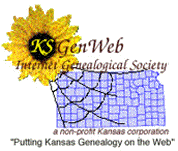
During the recent 11th Annual
Kaw Pow-Wow held on August 1-3, 1997, a group of descendents of 1902 Kaw
allottee Joseph Napoleon Bellmard gathered at the Washunga Cemetery near
Newkirk, Oklahoma to remember
their ancestor. The descendents,
who are all members of the Benbrook family and reside outside of Oklahoma,
were attending the Pow-Wow for the first time. By pure coincidence, the
first day of the Pow-Wow was the 150th anniversary of Joe Bellmard's birthday
(Joe was born in Kansas City, Missouri on August 1, 1847). The descendents
included two of Joe's grandsons, Jack Benbrook (Palm Springs, CA) and Jim
Benbrook (Gilbert,
AZ); Jack's son Jeff along
with Jeff's wife Sue and their daughter Jentri (Huntsville, AL); Jim's
daughters Christina Benbrook (Chandler, AZ) and Priscilla Benbrook (Tempe,
AZ); and Jack's grandsons Joshua and
Jayson Benbrook (Huntington
Beach, CA). Jack and Jim are the youngest sons of Glen Benbrook and Jane
(Jennie) Bellmard who also have two other children, Ernestine and Raymond,
that did not attend the Pow-Wow. Jane Bellmard was born in Washunga on
January 25, 1906 and is Joe's youngest daughter. At age 91, she is also
the oldest living member of the Bellmard family. On the second day of the
Pow-Wow the Benbrooks were
hosted by Colleen and Sam
Bellmard of Newkirk at an outdoor family gathering and lunch held at the
Newkirk Country Club. Colleen and Sam are also grandchildren of Joe Bellmard
through their father Raymond Bellmard. Raymond was the husband of Edna
Pappan, the oldest living Kaw and mother of Colleen and Sam.
Joe Bellmard is the son of Moses Bellmard and Adele Lessert who were married on January 7, 1841 at Kawsmouth, Missouri (present-day Kansas City). Moses was a French-Canadian born in Yamachiche, Quebec, Canada where he was baptized on May 9, 1812. Sometime in the late 1830s he left Canada and sailed down the Mississippi River then up the Missouri River to Kawsmouth were he bought a lot in the fledgling Town of Kansas. At Kawsmouth Moses did some farming but was also a skilled craftsman. Among his skills were those of wheelright and carpenter, both of which likely led to his employment by the powerful Chouteau family. Moses has been recorded as the builder of the Chapel of the Sacred Heart at Soldier Creek north of Topeka, Kansas sometime in 1850.
Adele Lessert was the daughter
of Clement Lessert, a French-Canadian who was a Kawsmouth neighbor of Moses
Bellmard, and Me-ho-yah, a daughter of the famous Kaw Chief White Plume.
Clement was employed as the Kaw Interpreter in 1825 at the first Kaw Agency
which was located at the foot of what is now Gillis Street in Kansas City.
Visitors to Kansas City can find an historical marker placed by The Chouteau
Society just
east of the 13th Street
Bartle Hall Convention Center underpass, on the grassy area below Barney
Allis Plaza, that describes old French Kansas City and includes a description
of the location of Clement's farm. Although he is not listed as one of
the signatories, Clement was apparently present at the signing of the Kaw
Treaty of 1825. On June 8, 1847, Richard W. Cummins (head of the Fort Leavenworth
Agency), accompanied by Clement, 3 Kaw chiefs, and 3 Kaw warriors set out
on mission to select a new location for the Kaw Reservation following the
signing of the Mission Creek Treaty of 1846. After a great deal of searching
they examined "the country known as the Council Grove and headwaters of
the Neosho," and were satisfied that this was the place to
which the Kaw should remove.
Adele was the recipient of one of the 23 half-blood reserves from the Treaty of 1825 and sometime shortly after her marriage to Moses, the Bellmards set up a residence north of present-day Topeka. It was on his mother's reserve that Joe Bellmard, along with his younger siblings Julia and Leonard, grew up. It must have been an exciting experience for these young Kaw mixed-bloods. The Oregon Trail, with its wagon trains full of emigrants heading for a better life in the west and forty-niners heading for the California gold fields, passed practically by their front doorstep. Soldiers traveling between Fort Leavenworth and Fort Riley or between Fort Leavenworth and the Santa Fe Trail would pass by and sometimes even camp on their land. Every summer the Kaws would come up from their Council Grove reservation and encamp " ... in the dooryards and around the premises of the Bellemeres, the Papans, the DeAubries, and others."
One of the most significant
events in Joe's life was his enlistment in the Union Army during the Civil
War. Joe, along with his second cousins and next-door neighbors Louis "Big
Louis" and Henry "Big Henry" Pappan,
enlisted in Company F, 15th
Kansas Volunteer Cavalry Regiment in September 1863. The young men enlisted
about two weeks after William Quantrill's infamous raid on Lawrence, Kansas,
presumably because Lawrence is only located about 17 miles from Topeka
and the Topekans feared another raid by Quantrill on their town since it
was the Kansas State Capitol. During the raid, which has been has been
described by historian Albert Castel as " ... the most atrocious single
event of the entire Civil War, nothing else quite matched it in stark melodramatic
horror", Quantrill and his followers brutally murdered 150 men and teenage
boys, an act that outraged the entire nation. Louis Pappan was
21-years old at the time, but
both Joe Bellmard and Henry Pappan were only
16, well under the legal enlistment age of 18. This fact was
conveniently overlooked by their
recruiting officer and Company F's commander,
Captain Orren A. Curtis. Capt. Curtis also just happened to
be the brother-in-law of
the Pappan brothers by virtue of his marriage to
their sister Ellen. Orren and Ellen Curtis were the parents of
Charles R. Curtis, fellow 1902
allottee of Joe Bellmard and future Vice-President
of the United States under Herbert Hoover, who was only 3
years old at the time.
The commander of the 15th
Kansas Cavalry was Colonel Charles R. Jennison,
a man who was as revered by many Kansans as he was hated by
most Missourians. Col. Jennison
had previously participated in the
"Bleeding Kansas" border
wars of the late 1850s and also served as the commander
of the 7th Kansas Cavalry ("Jennison's Jayhawkers") during the
Civil War. Jennison's men terrorized
many of the inhabitants of the
western Missouri areas bordering
Kansas since the Kansans felt that the Missourians
were harboring Confederate partisans or guerrillas, more
commonly known by the derogatory
term "bushwhackers". Some of the more famous
members of the 7th Kansas included Daniel Anthony, brother of
pioneer women's rights activist
Susan B. Anthony, James B. "Wild Bill" Hickok,
and William F. "Buffalo Bill" Cody. The next in command of the
Fifteenth was Lieutenant Colonel
George H. Hoyt, a young lawyer from Massachusetts
who had represented the famous Kansas abolitionist John Brown
during his 1859 trial for treason following Brown's failed
Harper's Ferry raid in Virginia.
The 15th Kansas Cavalry was
mustered-in at Fort Leavenworth, Kansas on October
2, 1863. Their mission was to protect the eastern Kansas border
from incursions by Confederate
guerrillas operating in western Missouri,
the southeastern Kansas
border from attacks by Confederate Indian troops stationed
in Indian Territory (Oklahoma), and the western end of the
Santa Fe Trail from attacks
by Plains Indians such as the Cheyennes,
Comanches, and Arapahoes.
In this capacity the three young Kaw quarter-bloods
of Company F spent much of the war stationed at lonely outposts
along the eastern Kansas border where they performed constant
patrol duty. This could be a
hazardous assignment, physically and mentally
demanding, always monotonous, and sometimes dangerous. Some of
their duty stations included
Fort Leavenworth, Topeka, Olathe, Mound City,
Barnesville, Eureka, and Fort Scott. In the summer of 1864 the
Fifteenth followed in the footsteps
of Jennison's Jayhawkers and began performing
jayhawking missions into western Missouri. This campaign was
highlighted by a skirmish with
a group of bushwhackers at Clear Creek, Missouri
in July 1864.
In October 1864 the regiment
participated in the largest Civil War land battle
to occur west of the Mississippi. Confederate General Sterling
Price (former Governor of Missouri)
led a 12,000-man army on a massive
cavalry raid into Missouri
and Kansas with the primary goal of capturing St.
Louis. The Fifteenth, led by Lt. Col. Hoyt, was a major participant
in the campaign and earned the
right to inscribe the battles of Lexington,
Little Blue, Big Blue, Westport, Marais des Cygnes, Osage,
and Newtonia on their banner.
During the October 19, 1864 Battle of Lexington,
Capt. Curtis earned the following commendation in leading the
men of Company F: "Many cases
of individual bravery made the [Lexington] engagement
brilliant. The action of Captain [Orren] Jack Curtis, in
cutting his way out of the rebel
lines, and rejoining the division was worthy
of all praise." After the Civil War ended in April 1865, the
regiment was retained on active
duty for another 6 months and was sent to
the western Kansas plains to help protect the wagon trains using the
Santa Fe Trail. During this
time period Joe Bellmard and the Pappan brothers
were stationed at Fort Larned and Fort Zarah.
The regiment was mustered-out at Fort Leavenworth on October 19, 1865 and Joe Bellmard returned to Topeka where he married Mary Susan Pappan on Christmas Day 1865. This union produced 6 children, William, Rachel, Julia, Joseph Jr., Mary, and Ida Bellmard. When Joe's mother Adele died around 1866, she was buried in Rochester Cemetery north of Topeka. After Adele's death, the government removed the Bellmards, Pappans, and other residents of the half-blood reserves to the Kaw Reservation at Council Grove. In 1873 the entire Kaw Nation was forcibly removed from Council Grove to Oklahoma Territory. Joe and Susan Bellmard, along with their two oldest children William and Rachel, moved to Oklahoma in a covered wagon, a journey that reportedly took about 17 days. In Oklahoma Joe did some farming and was also an accomplished musician, playing the fiddle for a fee at dances and other social events throughout the territory.
On January 30, 1899, Susan
Bellmard died and was buried at Washunga. With
3 young children still living at home, Joe did not remain single
for long and on May 8, 1900
he married Emily (Emma) Dawson Auld who had
moved from Illinois to Oklahoma
with her family in 1882. Joe's second marriage
produced 4 children, Raymond, Olavene, Jane, and Leonard "Bob"
Bellmard. Joe taught his two
youngest sons, Raymond and Bob, how to play
the fiddle and often took
them with him on a "gig". The two boys were accomplished
musicians in their own right and played professionally but
it has been said that Joe was
the best of them all. Because of his reputation
as a Civil War veteran, many of the young Kaw men who were
subject to the draft in World
War I came to see "Uncle Joe", as they called
him, to seek his advice about joining the army. He usually
advised them that they should
go ahead and enlist since they would probably
be drafted anyway. Several Kaws served with distinction during
W.W.I and on July 4, 1924
the administration of President Calvin Coolidge
honored them with a plaque which is now located in the Washunga
Cemetery. Joe Bellmard died
on March 22, 1925 having lived a full and
rewarding life.

